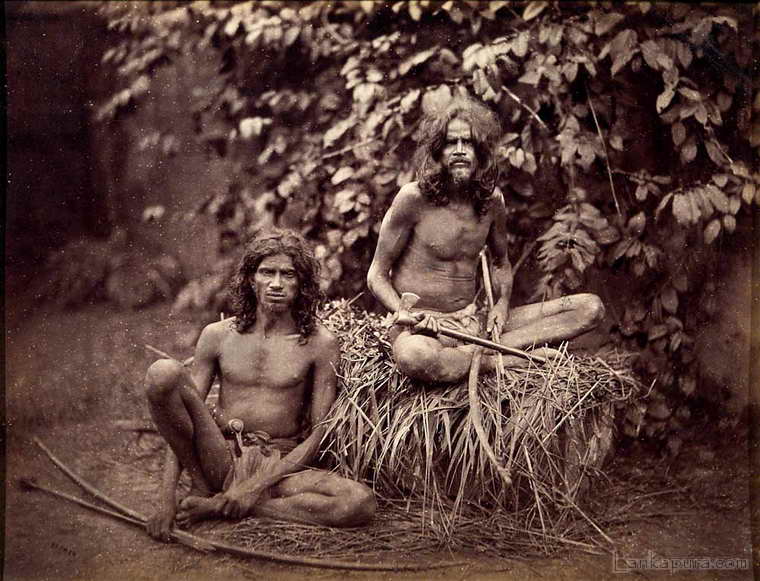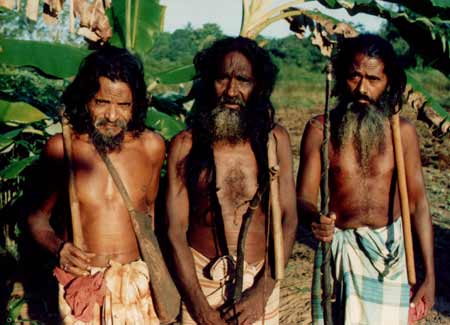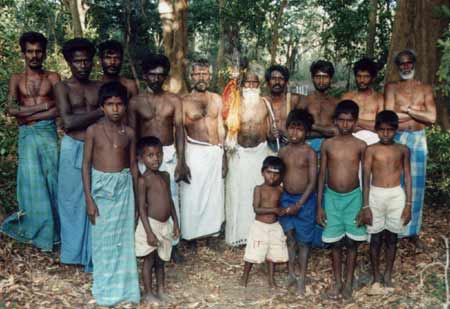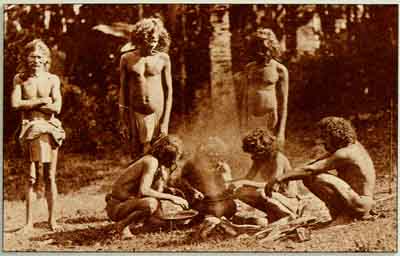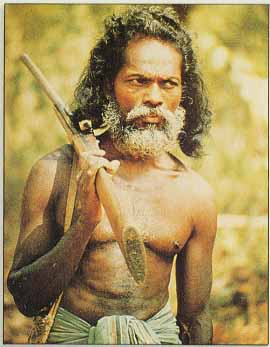
|
||||||||||||
The Curse of Kuveni: The Vedda and the Anti-Thesis of Modernization
Sudharshan Seneviratne For nearly two and a half millennia the Vedda withstood the ravages of cultural and technological encroachments of ‘civilization'. Today they do not possess any magic or charm powerful enough to stem the tide of ‘modernization' that is literary bulldozing its way though the once serene forest and ejecting its inhabitants from their natural habitat. The Vedda are facing the ‘final solution' or total obliteration though a process of assimilation as peripheral elements of the cosmopolitan civilization. They have finally come up against a techno-cultural contender capable of destroying the material basis sustaining them as a separate entity, which in itself is the antithesis to ‘civilization through modernization'. Community & Ecology The impact of the destruction inflicted upon the Vedda cannot be gauged until we appreciate the relationship between this community and its natural habitat. The institutional infrastructure of the Veddas is totally sustained by the forest ecology. The Vedda is essentially a hunter-gatherer. There is also the gam or ‘village' Vedda who conduct subsistence farming and coastal Vedda who thrive on the marine-littoral ecology. The above situation of the Vedda correspond to what has been called tribal or communal property relations (stammeigentum), which is the ‘undeveloped stage of production where a people sustain itself by hunting, fishing, cattle-raising or at most by farming' (Marx and Engels: The German Ideology). Their whole rhythm of life is ‘organically' linked to the flora, fauna and natural resources and also seasonal changes. This is best reflected in there periodic movements, which also characterize the Vedda as a nomadic community. The movement of animals, the availability fruit, and even trees such as riti (Antiari Innoxia), the inner bark of which is utilized to make short skirts, the occurrence of water holes (from which they obtain water and also where animals gather), rock ledges which give shelter and caves, particular raw materials e.g. quartz, jasper etc., have a direct bearing on their seasonal movements, camping sites and the continued use of these traditional routes by the Vedda.
The forest ecology also influenced the structural formation of the Vedda society. The restricted scale of localized resources and nomadism determined the size of the individual groups. A group is composed of the nuclear family or by a few extended families. The Vedda normally do not move about in large groups. These endogamous clans dwell within clearly demarcated territorial units. The nature of the hunting – gathering economy and the size of the individual group in turn have and influence on the division of labor, which is generally based on age and sex. The utilization of a simple technology, the less complex institutional and a dependence upon nature does not create a demand for luxury and other utilitarian items as done by settled agrarian or industrial societies. Conversely, it also does not encourage craft specialization. The Vedda even keep their personal belongings to the minimum, which is one way of facilitating, quick mobility. Most of these objects being in fact held on the basis of communal ownership.
The Vedda had even devised an exchange network covering a relatively extensive physical area. The internal network, which operated within the Vadda community, depended upon the availability of localized resources, such as, beehives, meat, particular varieties of stone, animal skins etc. Often periodic movements were utilized as exchange journeys. Certain resources also exchanged hands as bride price during marriage. Some chieftains may have had a socio-political advantage over others by virtue of being in control of areas having a greater concentration of natural resources or having objects of ‘prestige' value. Particular items such as salt, iron tools, grain, shell, trinkets that are not available within the forest ecology have to be obtained externally from other techno-cultural groups (some times via ‘silent-barter') in exchange for forest products. The forest ecology also has a strong influence on the ritual structure of the Vadda. The totemic affiliation of clans, the deification of trees, rocks, hills and ponds (often located at important places along migratory routes or at territorial boundaries), the belief in a life after death and ancestor worship, charms and songs to invoke the blessing of protective spirits, are all part of the relatively complex ritual structure associated with their tribal pantheon. Even the beginning and the termination of seasonal movements tend to culminate in clan or tribal gatherings during a particular time of the year at specific traditional centers often identified with sacred spaces. Such centers and gatherings have extremely important socio-ritual significance to the Veddas. This clearly shows that the self-perpetuation of the Vedda institutional structure is clearly linked to particular forest ecological systems. A disturbance of this delicate relationship will, therefore, quite clearly destabilize the structural basis of this community and threaten the existence of the Veddas as an individual techno cultural group. For example, as a consequence of the disintegration of a particular culture, there is also a decline in the associated language medium. This decline is further precipitated by the introduction of dialects associated with intrusive techno-cultural groups. Each language invariably carries the individuality associated with a particular cultural milieu. The functional uses of words essentially originate and evolve within a specific social and technological context. With the destruction of a particular institutional infrastructure the language is deprived of its cultural basis and is relegated to a background position only to remain at the sub – stratum level and finally to be obliterated. Similarly the disintegration of these forest dwelling hunter–gatherers will consequently deprive the field of social science of one of the most valuable case studies on ethnology. The appeal to treat the Veddas with dignity is not an effort to preserve an idyllic picture or to romanticize the Veddas or alternately ‘anthropologize' them in order to have laboratory specimen for research in the social and the biological sciences. Such communities form a vital link in reconstructing the techno-cultural antecedents of institutional formation. The invaluable evidence rendered by studies made on the Indian indigenous communities to the fields of ethno history and ethno archaeology prompted D.D kosambi to identify the sub-continental tribal culture as the ‘Living pre history of India'. On the basis of archaeological, physical and cultural anthropological research, the Vedda may be called the linear descendents of the Pre Historic Mesolithic people of Sri Lanka. Hence, the ethnology of the Veddas form an integral part of Pre Historic archaeology in this country.
Hegimonizing the Vedda Have we really understood and grasped the implications of this disruption caused to a total rhythm of life and its ecological base associated with an ethno-cultural group? The total apathy shown by the general public about the recent eviction of the Vedda from their traditional home is a reflection of our deteriorating standards of social awareness and our incapacity to relate ourselves to society and its realities. This necessarily poses interesting questions about our historical, social, cultural and even academic attitudes towards the Vedda as an ethno-cultural group with a separate identity. The central question is, to what extent are we willing to recognize the individuality of ethno-cultural groups? Are our attitudes and action guided, consciously, or unconsciously by national chauvinism, the colonial hangover or by the long arm of neo-imperialism? For all practical purposes the Vedda consider themselves an autonomous community. There is in fact much ambiguity over the extent to which the pre colonial and colonial rulers exercised their hegemony over this community. ‘The whole country was ours before the Singhalese came' was the proud assertion of a Vedda (Henry Parker. Ancient Ceylon 1909). The Vedda have their own code of ethics and other social, economic and political interactions within the jungle habitat. Hence, all other intrusive techno-cultural elements are considered ‘alien'. Ironically the concept of an autonomous ethno-cultural group is ‘alien' to our institutional and psychological framework as well. Firstly, as successors to our colonial masters we believe in our sole right to exercise undisputed hegemonic power over the whole island community. This is especially so when there is a growing demand for our island society to be totally integrated to the global economy in the form of a consumer and labor market by international entrepreneurs. Secondly, as a community, we have not lacked the necessary psychological make-up to realize our historic mission or to launch a crusade to ‘civilize' the less developed beings in this country. According to the details in the Dipavamsa and the Mahavamsa, the original crusade was carried out with brutal efficiency. The earliest ‘colonizers' according to the texts, initiated the civilizing process either by integrating the autochthonous groups culturally or by annihilating them physically and banishing the remnant to the peripheral hills, thus socially ostracizing the Yakka. Our ancestors thereby inherited the most fertile tracts suitable for agriculture and areas having natural resources providing them with the material foundation to establish the ‘island of Righteousness'' (dharma dvipa). The process of acculturation initiated by the ‘Great Tradition' could neither obliterate the cultural individuality of autochthonous groups nor dislodge them from their ecological niche and habitat. It was perhaps the nonexistence of a global economy that saved these hunter-gatherers from total disappearance during the pre modern period. Precisely due to the above reasons, the evolution of a particular community as an individual ethno-cultural group is totally opposed to our concept of national chauvinism. We have gradually come to see a natural equation between ethno-cultural groups and self-determination. For instance, the systematic introduction of the Sinhala – Tamil dichotomy and the vertical split of two communities on regional, cultural and linguistic lines and its crude external expression in the from of an imagined racial division, is a living example of our capacity to perpetuate national chauvinism. The problem really become acute when a numerically larger, technologically superior, economically more complex society attempts to establish its hegemony over an ethnic group located in a clearly demarcated physical area (traditionally held as their territorial and ecological zone) sustaining a particular economy and culture which assigns an individual identity to that community within this island society. The Vedda have been on the retreat since the 19th Century. More specifically with the inauguration of the colonization schemes new techno – cultural elements operating an entirely different economy gradually chiseled into Vedda territory. (Curiously enough, texts mention that the earliest settlers from North India also came as ‘colonizers'). With the planned destruction of the forest ecology, greater number of the Vedda had to take up to subsistence farming for survival. This group more popularly known as the gam (village) Vedda represent the most backward and impoverished section amongst the poor peasants in the rural economy of Sri Lanka. What was left from this onslaught of the ‘civilizing' process retreated to the central Mahaveli basin Dialectics of Development The present phase of modernization threatening the Vedda is nothing but the long arm of the ‘development strategy'. Externally this strategy is linked to the global economy – an economic superstructure that knows only one law in the Third World i.e. the ‘development of underdevelopment' (with apologies to A. Gunder Frank). The less attractive internal side of the ‘development strategy' in terms of its economic implication, social and ecological instabilities has been discussed by others who do not adhere to this development myth. The reclamation of the existing forest tracts is partly an effort to establish the new ‘latifundia' complex largely financed by the multi-nationals investing in commercial crops for the export-oriented International agro-business. It has an amazing capacity to persuade States in the Third World countries to implement policies against their own people!
The eviction orders issued to this community in January, only reflects the scant regard paid by the State to the fate of the Vadda who are struggling to cling on to their last ecological base. The mere assignment of another forest reserve does not necessarily compensate for the loss of their historical habitat. There is no guarantee that the new forest reserves contain sufficient game or floral resources for gathering. Its is also not known to what extent the new locality has potential for other resources such as bee-hives, caves, water holes and particular verities of stone for their tools. They will also be deprived of their traditional sacred spaces associated with trees, ponds, lakes and other socio-ritual centers. The original cave sites where their departed ancestors have been buried or the traditional routes the Veddas used and have been so closely associated with their socio-economic interactions for centuries will be out of bounds to them forever. Thus the ‘Accelerated Mahavali Programme' is actually completing the mopping – up operation of the Vadda who have now reached the end of their ‘Long March' in history. It is quite relevant in this context to describe the actual destruction that has been inflicted on the tribes in India through State sponsored modernization. The following extracts are from the chapter ‘How public-sector projects displaces tribals' in The Tribal Problem in India, A.B. Bardhan (1973:63-71): "…the areas they inhabit are potentially some of the richest in our country. They are endowed not only with the vast wealth of the forest, but also possess inexhaustible stores of mineral ores. The course of industrial and economic development after independence has naturally attracted to these areas as sources of raw material and bases for giant projects. In the process of constructing these national projects, tribals have been dispossessed of their lands by the due processes of law and have been paid cash compensation. But the money was squandered away, and the tribal soon become penniless and landless. What happened to the tribals in India after the first taste of ‘Industrialization' is even more shattering. Most of the undertakings are no doubt in the public sector. But they are a part of the over-all capitalistic development pursued by the bourgeoisie. They bring in their train contractors, trading bourgeois and a host of other petty-bourgeois fortune-seekers and lumpens. They bring along and bestow such choice blessings as prostitution, VD, moral degeneration and disruption of social and cultural values that had been ingrained for so long in the psychological makeup". The tragic fate of the tribal communities in North and South America, Africa and Australia is too well known to be repeated here.
There is however, a vital difference between the attitudes displayed by the tribals of India and Sri Lanka in response to encroachments made by alien techno-cultural groups. In Sri Lanka, the Vedda have generally submitted or retreated after passive resistance in face of intrusions during the 19th and 20th Centuries. In India, on several occasions the tribals at first challenged the Colonial rule including the feudal elements during the 19th century and later opposed the encroachments made by merchant and industrial capitalists during the present century. A series of tribal revolts launched since the mid 19th Century by the Santal, Kol, Munda, Koya, Kurichias, Naga and Mizo tribes, is a clear expression against the culture and economy nourished by colonialism and capitalism. Whether these revolt were successful or not, such upheavals, as Marx pointed out (The British rule in India) may be shown as the ‘positive aspects' of British colonialism which acts "…as the unconscious tool of history bringing about that revolution", i.e. social revolution, precisely due to the dialectical contradiction created by mercantilism (and subsequently) industrial capitalism in colonial and neo-colonial countries. Do ‘modernization' and our integration to the world economy also mean the acceptance of uniformity in culture? Does the vertical penetration of the consumer-oriented cosmopolitan culture also require the horizontal integration of all communities and resources? Under the hegemony of the colonial metropolis and neo-imperialism, we have come to accept various norms related to the cosmopolitan global civilization. We have also proved our selves to be a highly adaptable people. As a consequence, we have become great exponents of ‘civilization through modernization'. Ironically enough, our enthusiasm for development has given Social Darwinism a new lease of life in this part of the world. Thus in order to modernize the bakcward section of our society and economy we must re-enact the tragi-comedy of carrying the ‘White Man's burden' on the Brown man's shoulders. In addition, Social Darwinism also provides the best psychological environment to legitimize the concept of laissez-faire which links us organically to the global economy of world capitalism. As agents of this cosmopolitan culture, what do we stand to gain in qualitative terms by imposing a ‘counter culture' on other ethno and techno-cultural groups? As early as 1908, Ananda Coomaraswamy pointed out this contradiction between our cultural aspirations and the concept of progress. "Talk of progress and the reality are not the same. Civilization is supposed to advance by the creation of new desires, to gratify which the individual must endeavor to improve his position. But in reality it is not quantity, but quality of wants that may be taken as evidence of progress in the art of living. No one acquainted with modern Singhalese taste will pretend that it gives evidence of any improvement in the quality of wants. Indeed, it is sufficiently obvious that quantity, variety and novelty are not really compatible with quality". A most appropriate observation that is valid even in the present context. Our society in Sri Lanka is indeed a living example of how ‘material advancement' in a dependent economy is nothing but a borrowed luxury imposed from above at the expense of political freedom, economic under development, cultural degeneration, ethical impoverishment and intellectual lupanization of the community as a whole. This is the real Curse of Kuveni we are destined to carry with us throughout history. Orginally published in THE LANKA GUARDIAN, Vol. 6 (1983) |
| Living Heritage Trust ©2024 All Rights Reserved |
